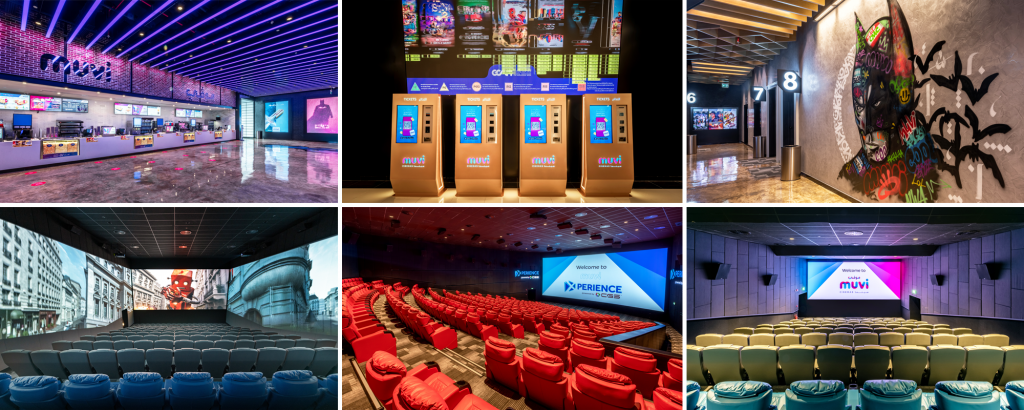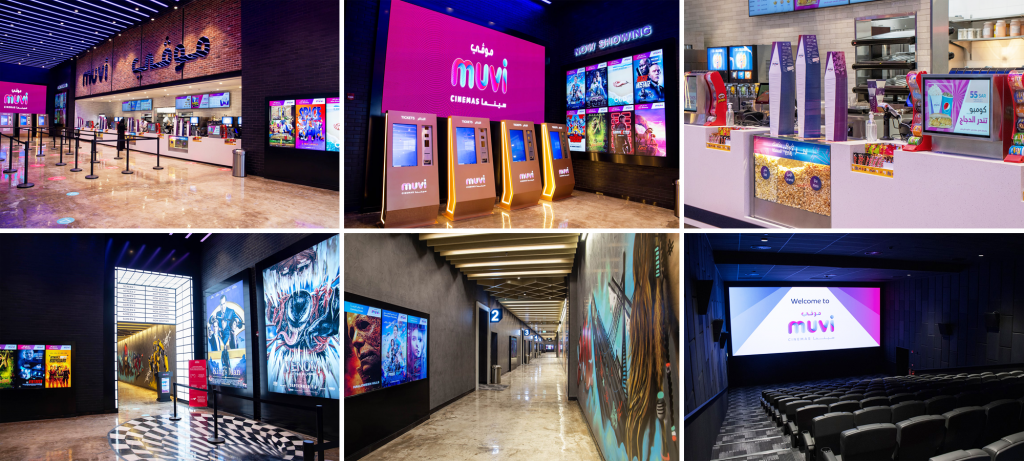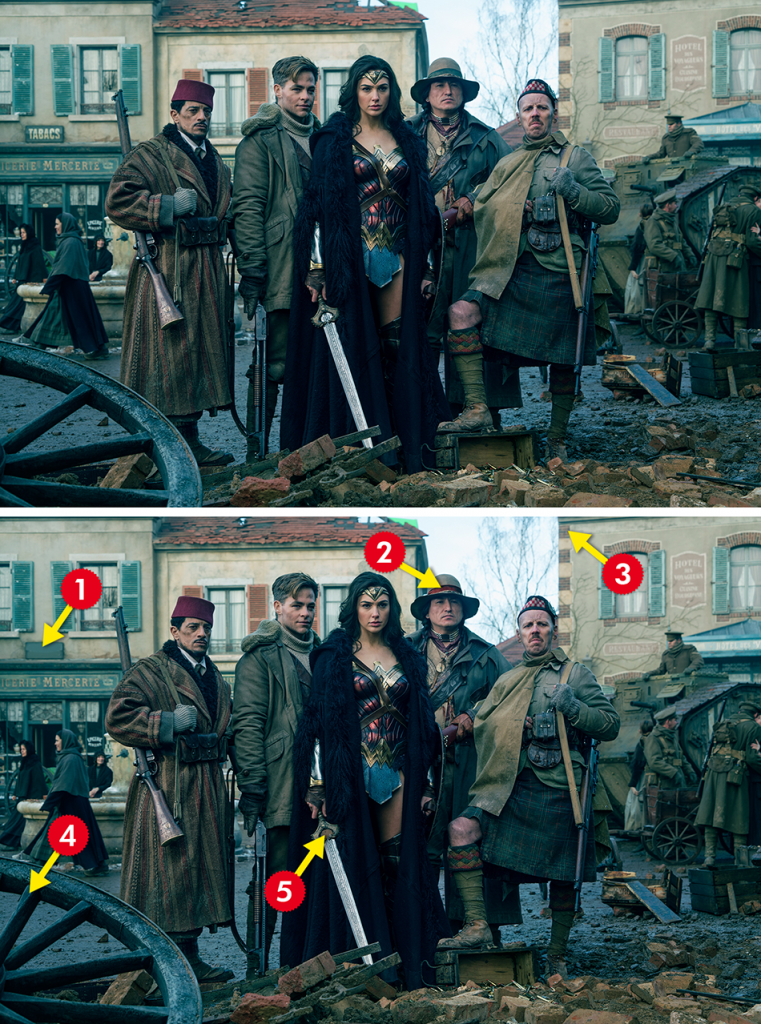Fatma Al Suwaidi, a third year student majoring in Advertising at American University in Dubai to represent the UAE at the exclusive Cannes Lions Roger Hatchuel Academy 2022
The Roger Hatchuel Student Academy, founded in 2003, is a unique learning experience designed to help students interested in pursuing a creative path in advertising launch their careers. Selected students learn first-hand from the world’s greatest brands, creative minds and industry leaders, and the programme takes place over the week of the Cannes Lions International Festival of Creativity in Cannes, France.
As the official UAE representatives of the Cannes Lions Festival, Motivate Media Group and Motivate Val Morgan are delighted to announce that Fatma Al Suwaidi, a third year Visual Communications student majoring in Advertising at American University in Dubai (AUD), has been selected to represent the UAE at the exclusive Cannes Lions Roger Hatchuel Academy 2022
Fatma was one of the three recommended students from the UAE this year, alongside Kenzy Abedelmaksoud and Lillian Ghousseini also from AUD, whose submissions were reviewed by the Roger Hatchuel Academy selection panel – a diverse mix of global experts from reputed education institutions, the industry and related creative fields.
Commenting on being selected for this year’s Roger Hatchuel Academy, Fatma said, “If someone had told me at the start of my academic studies that I would become the passionate advertising creative I am today, I would not have believed them. Not because I thought I wasn’t capable, but because I grew in so many ways, that I exceeded my own expectations. I am nearing the end of my studies at AUD, but my journey in seeking knowledge is forever ongoing, and to be selected in my senior year to represent my country at the prestigious Roger Hatchuel Academy is an honor and I look forward to learning from the very best.”
“I am certain that attending the Cannes Lions Festival will be an experience packed with creativity, inspiration and just pure passion. My selection is a triumph I am proud of; however, it is not something that I accomplished alone, I owe my thanks to my family who supported me, my friends who were by my side, my university for giving me the foundation I need, and last but not least, Professor Dina Faour, a true role model every student would be lucky to have,” she added.
Dina Faour, Professor of Advertising, Department of Visual Arts, American University Dubai said, “We are so excited to witness yet another year for AUD at the one and only Cannes Lions and, specifically, at the Roger Hatchuel academy. This is a clear attestation to the program, the curriculum, the team, the students and the work. We wish Fatma AlSuwaidi a journey filled with inspiration and creativity, and we just know she’ll do us proud. We want to thank Cannes Lions for supporting students with this exclusive academy that joins the best students around the globe in one classroom and offers them such a unique insight into the industry. Thank you Motivate Media Group and Motivate Val Morgan, for being so professional, you certainly deserve to represent this festival.”
The Roger Hatchuel Academy class of 2022 will host 30 students in total, and throughout the week-long programme, students will dissect diversity and unlock a greater understanding of each other, the world and the nature of the industry.
Other areas covered include:
This year’s Roger Hatchuel Academy will run in parallel to the Cannes Lions Festival from 20 – 24 June 2022. Motivate Media Group and Motivate Val Morgan wishes Fatma Al Suwaidi the best of luck as she embarks on this journey, and we hope her experience and learnings at the Roger Hatchuel Academy will create positive impact and contribute to her future endeavours in the industry.
Muvi Cinemas opens the first ever movie theater in the city of Khamis Mushait in Saudi Arabia at Mujan Park – Khamis
Muvi Cinemas opened its newest location at Murjan Park in the city of Khamis Mushait – KSA, on 11January 2022.
The 9-screen cinema with a total of 1,368 seats also features a ScreenX and Xperience screen, and is the first ever theatre in the city of Khamis Mushait – a city in south-west Saudi Arabia, located east of Abha.

Similar to other locations operated by the exhibitor, Muvi Cinemas at Mujan Park – Khamis was designed by UK’s , and the mall the cinema is located in boasts a wide range of entertainment and shopping options, restaurants, and cafes for the entire family to enjoy and experience.
Together with the openings of muvi Boutique – Tala Mall and Boulevard Riyadh (which opened in December 2021) and Al-Yasmin Mall (which opened in January 2022), Muvi Cinemas presently operates 174 screens across 20 locations in 9 cities across Saudi Arabia.
*More information on muvi Boutique – Tala Mall (Riyadh), Boulevard Riyadh (Riyadh) and Al-Yasmin Mall (Jeddah) to follow soon.
Contact us for cinema advertising opportunities on the screens of first ever cinema in Khamis Mushait, KSA – Muvi Cinemas Mujan Park – Khamis.
Muvi Cinemas – Salaam Mall in Riyadh is the latest cinema to open as part of the exhibitor’s roll out plan to grow to 307 screens across the Kingdom of Saudi Arabia over the 12 months ahead.
Muvi Cinemas opened its thirteenth location at Salaam Mall in Riyadh on 1st December, 2021. The cinema features 8 standard screens with a total of 1,056 seats.

Similar to other Muvi locations, Salaam Mall – spanning 3,274 sqms, was designed by UK’s Chapman and Taylor and has a theme of urban downtown, with the intention of creating a dynamic, modern and innovative cinema experience. Internal spaces are characterised by an industrial, yet luxurious, material palette, including timber, exposed steelwork, exposed brickwork and an exposed concrete floor. Digital LED screens and dramatic lighting installations complement the city warehouse feel, providing a strong visual identity for the cinema exhibitor.
Located in Riyadh’s suburban Alawali area, Salaam Mall offers a great stop for shopping dining and entertainment.
Muvi Cinemas presently operates 127 screens across 13 locations in 8 cities across Saudi Arabia.
Contact a member of our sales team for cinema advertising opportunities on the screens of Muvi Cinemas –Salaam Mall.
Sources: Zawya and MUVI
From John Lewis, to M&S and Disney, here’s a list of the best Christmas ads in 2021 from around the world.
We’re at that time of year again, when the Christmas ads we see leave us feeling nostalgic, teary-eyed, emotional and in the mood for holiday time spent with family. They also give us a sense of collective spirit.
In contrast to subdued messages of pandemic stricken 2020, brands have gone all out with their storytelling this year. From fantasy filled extra-terrestrial scenarios, to intimate tales of holiday gatherings, here’s a collection of all the festive Christmas ads from your favourite brands and retailers, including the much talked about ones from John Lewis and M&S.
Check out the best Christmas ads of 2021 that reflects a year full of change, hope and joyful optimism:
John Lewis & Partners – Unexpected Guest
The U.K. retailer is back with a heartwarming tale set to cover of ‘Together in Electric Dreams’. The two-minute advert, entitled ‘Unexpected Guest’, is a joyful story of friendship between a young boy called Nathan and the space traveler, Skye, as they celebrate the magic of Christmas moments.
M&S Food – Percy Pig comes to life for the first time EVER!
Marks & Spencer’s Christmas advert for this year features Spiderman star Tom Holland as the voice of Percy Pig. The Christmas clip, which also stars Dawn French as a festive fairy, sees Percy Pig come to life and explore the treats on offer in an M&S food hall.
Aldi: Ebanana Scrooge
Aldi has released a charming Dickensian-style take on ‘A Christmas Carol’ with a spot that follows the story of Christmas loathing Ebanana Scrooge, who is reminded of the joys of the festive season by Kevin the Carrot. It’s part of a seasonal campaign that will see 1.8 million meals donated to families that need help across the UK over the festive period.
GAP – All Together Now
Katy Perry sings a Beatles song – ‘All You Need Is Love’, while playing the guitar in GAP’s 2021 Christmas advertisement.
Disney – The Stepdad
Disney celebrates blended families with its new Christmas ad. The Stepdad is a beautiful animated short that sees a new stepfather moving in with the family at the beginning of the holiday season, and it’s such a lovely example of how families can learn to interact with each other… you are definitely going to cry at least once when watching the ad. The Stepdad is a sequel to last year’s animated short from Disney – Lola.
Sports Direct – GO ALL OUT This Christmas
It’s the most expensive Christmas advert ever. And with tennis champ Emma Raducanu and football ace Jack Grealish leading a line-up of 16 sports stars, it is bound to score highly with viewers.
Boots: Bags of Joy
BAFTA-nominated actress and ‘Doctor Who’ star Jenna Coleman plays the leading role in Boots’ festive ad for 2021. As Boots puts it, “This Christmas is all about joy.” The joy of being with friends and family, the joy of getting out there and connecting with each other.
Argos: Baubles to Last Year! Christmas is On
Another British retailer to recognise our appetite for going BIG this festive season given the disappointment of last year. The campaign shows the pure joy of Christmas and all the ways we can make a big splash. The 60-second fun spot reminds us that Argos is a decent source of inspiration for shoppers looking for that perfect gift for family and friends.
Asda: Make Christmas Spectacular
Asda’s Christmas spot which features a family gliding through the festive season on their ice skates. The ad is about making the festive season ‘spectacular’!
Morrisons: Farmer Christmas
Morrisons is introducing Farmer Christmas to the nation with its festive ad this year, following two young friends who discover the other hero of Christmas. The 60-second spot tells a tale about Farmer Christmas who works all year too in order to deliver a delicious Christmas feast to tables across the country.
Coca-Cola: Chimney
Coca-Cola is another brand to into some real magic this Christmas with its festive ad that focuses on the concept of community. Featuring a story of a young boy who brings his apartment block together to celebrate the holidays, it opens with his desire to create a chimney out of cardboard boxes, ready for Santa Claus to deliver presents
Have a Christmas ad you would like to run in cinema? Contact us for more information on advertising across our circuit in the GCC.
Sources : Creative Boom, The Sun, Daily Mirror
In this edition of ‘What’s Buzzin Behind the Screen’, we bring you the latest industry news – everything you need to know about what’s happening behind the scenes in Hollywood. From the latest trailer releases, to box office collections and movie announcements, here’s the October 2021 update:
Stay tuned for the latest industry news in our November 2021 edition.
Source: Screen Rant, The Hollywood Reporter, Variety, Rotten Tomatoes and Cinema Blend
With the reopening of cinemas in most states of India, Asian movie lovers will witness the return of the much anticipated movie releases on the big screen, that were previously pushed back due to the ongoing pandemic.
Cinema theatres in India and overseas markets popular for Indian movie releases, are anticipating heavy footfall during the Diwali weekend, which falls on 4 November 2021, for the line-up includes both regional and big-ticket titles.
From Akshay Kumar’s Sooryavanshi, Rajinikanth’s Tamil movie Annaatthe and more, here is a comprehensive list of Asian movie releases over the remainder of 2021:
Star (Malayalam)
Synopsis: Prithviraj plays Dr Derrick who tries to unearth the mystery in the story. The mystery of star – the Betelgeuse in the Orion constellation.
Release Date: 28 October 2021
Cast: Prithviraj Sukumaran, Joju George and Sheelu Abraham
Sooryavanshi (Hindi)
Synopsis: Sooryavanshi traces the acts and serious antics of DCP Veer Sooryavanshi, the chief of the Anti-Terrorism Squad in India.
Release Date: 4 November 2021
Cast: Akshay Kumar, Katrina Kaif, Ajay Devgn and Ranveer Singh
Annaatthe (Tamil)
Synopsis: Directed by Siruthai Siva, Annaatthe is a rural action-entertainer with Rajinikanth playing the role of a village headman.
Release Date: 4 November 2021
Cast: Rajinikanth, Nayanthara, Prakash Raj and Keerthy Suresh
Bunty Aur Babli 2 (Hindi)

Synopsis: Bunty and Babli are forced out of retirement after a spate of robberies with their trademark sigil start appearing across India.
Release Date: 18 November 2021
Cast: Saif Ali Khan, Rani Mukerji and Pankaj Tripathi
Satyameva Jayate 2 (Hindi)

Synopsis: Revolves around the fight against injustice and misuse of power. From police and politicians to industrialists and a common man, the film will explore corruption in all spheres.
Release Date: 25 November 2021
Cast: John Abraham, Divya Khosla Kumar and Anup Soni
Maanaadu (Tamil)
Synopsis: On the day of a public conference by the state’s Chief Minister, his bodyguard and a police officer are stuck in a time loop.
Release Date: 25 November 2021
Cast: T.R. Silambarasan, Kalyani Priyadarshan and S.J. Suryah
83 (Hindi)

Synopsis: The story of India’s incredible cricket World Cup victory in 1983. The World Cup that taught India to win.
Release Date: 23 November 2021
Cast: Ranveer Singh, Deepika Padukone and Tahir Raj Bhasin
Pushpa: The Rise (Telugu)
Synopsis: Based on the smuggling of red sandal trees in Seshachalam forest|
Release Date: 23 December 2021
Cast: Allu Arjun, Fahadh Faasil and Rashmika Mandanna
Jersey (Hindi)

Synopsis: The about a thirty six year old cricketer who stopped his cricketing career ten years ago, and now aiming to return to the Indian Cricket team to realize his son’s dream and to prove his ability
Release Date: 30 December 2021
Cast: Shahid Kapoor, Mrunal Thakur and Palak Singh
*Movie release dates are subject to change
Advertisers… here’s your chance to target Asian audiences in the lead up to Diwali and over the rest of Q4 2021. Mark your calendars and contact us to plan your cinema advertising campaigns alongside these Asian movie releases.
Sources: IMDB and VOX Cinemas movie release schedule
Saudi Arabia celebrated its 91st National Day (also known as Al-Yaom-ul-Watany) on 23rd September 2021, commemorating the birth of the modern Saudi nation.
This year’s theme and slogan was ‘Heya Lana Dar’, which means ‘A Home for Us’ – appreciating the spirit of the country’s cultural diversity that makes everyone (Saudis and foreigners) feel at home.
To honour and celebrate the transformative journey the country has embarked on over the past 91 years, leading brands in Saudi Arabia launched cinema campaigns across the country:
Saudia
The national airline of Kingdom of Saudi Arabia launched its national day cinema campaign emphasizing the spirit of being a Saudi national and its prosperity through generations.
Commercial Duration: 60 sec.
Campaign Duration: 21 – 24 September 2021
Locations: VOX Cinemas (Riyadh Front and Red Sea Mall), Muvi Cinemas (Nakheel Mall and Mall of Dhahran), AMC Cinemas – Stars Avenue and Cinépolis Cinemas – Lulu Mall
STC
Saudi Telecom Company launched its cinema campaign that parades the evolution of digital life in the kingdom.
Commercial Duration: 90 sec.
Campaign Duration: 23 – 25 September 2021
Locations: VOX Cinemas (Riyadh Park Mall and Red Sea Mall), AMC Cinemas – Panorama, Muvi Cinemas (Mall of Arabia and Nakheel Mall) and Cinépolis Cinemas – Lulu Mall
Banque Saudi Fransi
The Saudi based banking group’s national day campaign celebrates the vision and achievement of Saudi Arabia as a nation in various sectors.
Commercial Duration: 30 sec.
Campaign Duration: 21 – 27 September 2021
Locations: VOX Cinemas (Riyadh Park Mall, Kingdom Tower, Riyadh Front and Red Sea Mall), AMC Cinemas (Panorama and Riyadh Gallery) and Muvi Cinemas (Nakheel Mall Riyadh, U Walk, Mall of Arabia, Nakheel Mall Dammam and Mall of Dhahran)
Tamimi Markets
One of the fastest-growing supermarket chains in Saudi Arabia booked an ad to commemorate the Kingdom’s prosperity and greatness.
Commercial Duration: 15 sec.
Campaign Duration: 22 – 28 September 2021
Locations: 25 locations covering multiple VOX, Muvi, AMC and Cinépolis cinema locations
The General Presidency for the affairs of the Grand Mosque and the Prophet’s Mosque
The government agency launched its campaign welcoming pilgrims and aiming to facilitate worshipers to perform the religious worship at the grand mosques with a prompt for being dutiful and generous in the times of the pandemic.
Commercial Duration: 60 sec.
Campaign Duration: 23 – 25 September 2021
Locations: VOX Cinemas – Town Square, Muvi Cinemas – Nakheel Mall in Dammam and AMC Cinemas – Azizia Plaza
With National Days of Oman (18th November), UAE (2nd December), Bahrain (16th December) and Qatar (18th December) around the corner, contact a member of our sales team for more information on cinema advertising opportunities to mark these special days!
A big congratulations out to the winner of the MVM ‘Spot the Difference’ challenge: Cristina Oanes from C2 Communications.

Having successfully spotted the five difference between the two images, Cristina won 2 x VOX Cinemas movie passes to watch a movie of her preference.
Below are the five differences between the two images:

Thank you to all who participated, and stay tuned for future Motivate Val Morgan competitions!
Ahead of LIONS Live (22-26 June, 2020), Cannes Lions has launched the Young Lions Live Award. The global challenge gives creatives from 18-30 years old the chance to answer a brief from humanitarian organisation, the United Nations World Food Programme.
The brief calls on extraordinary young talent for creative ideas to help rebalance the food waste-starvation equation.
Participants will have until 14 June to enter their work. Entries will be judged by Cannes Lions jurors and winners, announced on 26 June, will receive a complimentary pass to Cannes Lions 2021.
In partnership with humanitarian organisation, the UNWFP, our brief calls for creative ideas that can help to rebalance the waste-starvation equation –encouraging people to waste less food and contributing to ending world hunger at the same time.
The briefing pack is now available and you’ll have up until 14 June to create a 90 second film and a 500 word description explaining your idea. Please note both must be in English though your film can be subtitled.
The competition is open to individuals or teams of two and you must be aged between 18-30 years old. Please note you will be required to supply proof of age when registering. Winners receive complimentary passes to Cannes Lions 2021.
Click here to download briefing pack
When will the winner(s) be announced?
On Friday 26 June as part of Lions Live, we will announce the winner(s) to the world.
What is the deadline to submit my entry?
You must submit your entry no later than midnight in your country on 14 June
Can I have a deadline extension?
Unfortunately no deadline extensions will be granted.
Can I enter more than once?
Yes but each entry must be unique.
Does my video need to be 90 seconds?
Your entry can be less than 90 seconds but it should not exceed 90 seconds in length.
What kind of video should I produce?
Judges are looking for a 90-second or less case film, describing your idea and detailing how any online executions could work. Your film can include visual or design elements and, if a TV spot or online video is part of your idea, you can include that, too.
What should the 500 word description include?
Creative idea or insight
Description of the strategy, target audience, planning and approach
Explanation of implementation, integration, timeline and scale
How much does it cost to enter?
Nothing. There is no fee!
Am I eligible to enter?
Anyone aged between 18-30 can enter. You might be a student, working as a creative in an agency, a brand marketer, a coder, an artist etc etc. Everyone is welcome providing you are born on or after Jun 27, 1989.
Click here to enter.
Source: Cannes Lions
The Global Lions Creativity Report will celebrate sustained creative success
Winners will be announced throughout the week of LIONS Live
Cannes Lions has announced that it will release a Global Lions Creativity Report of the Decade in June to celebrate and recognise sustained creative success.
It is the first time in Cannes Lions’ history that data from across ten years will be used to compile a global rankings and benchmarking report. The winners will be announced throughout the week of LIONS Live, 22-26 June, with acceptance speeches and reels of work screened live to the world through the platform.
About the report, Simon Cook, Managing Director, Cannes Lions, said: “Every year, our global juries only award around 3% of entries, which means if you win a Lion – whatever the metal – it’s recognition of truly game-changing, creative excellence. This first of its kind report will recognise and celebrate those that have performed to that level, consistently, over the last decade. It will celebrate a body of work that has made the recipients the most creative companies in the world. We hope the report will also serve as a valuable and inspiring learning resource and clearly show what sustained creative success looks like.”
The Global Lions Creativity Report of the Decade will announce winners in the following categories:
The report is being produced together with Cannes Lions’ sister company, WARC, who will provide editorial commentary and insights on the rankings. The full report will be made available to everyone after the results have been announced at LIONS Live, the new digital experience and platform for the creative community.
LIONS Live will unite the world’s global creative community with a free agenda of live-streamed and on-demand content running from 22-26 June.
Click here for further information on LIONS Live.
Source: Cannes Lions (Press Release)